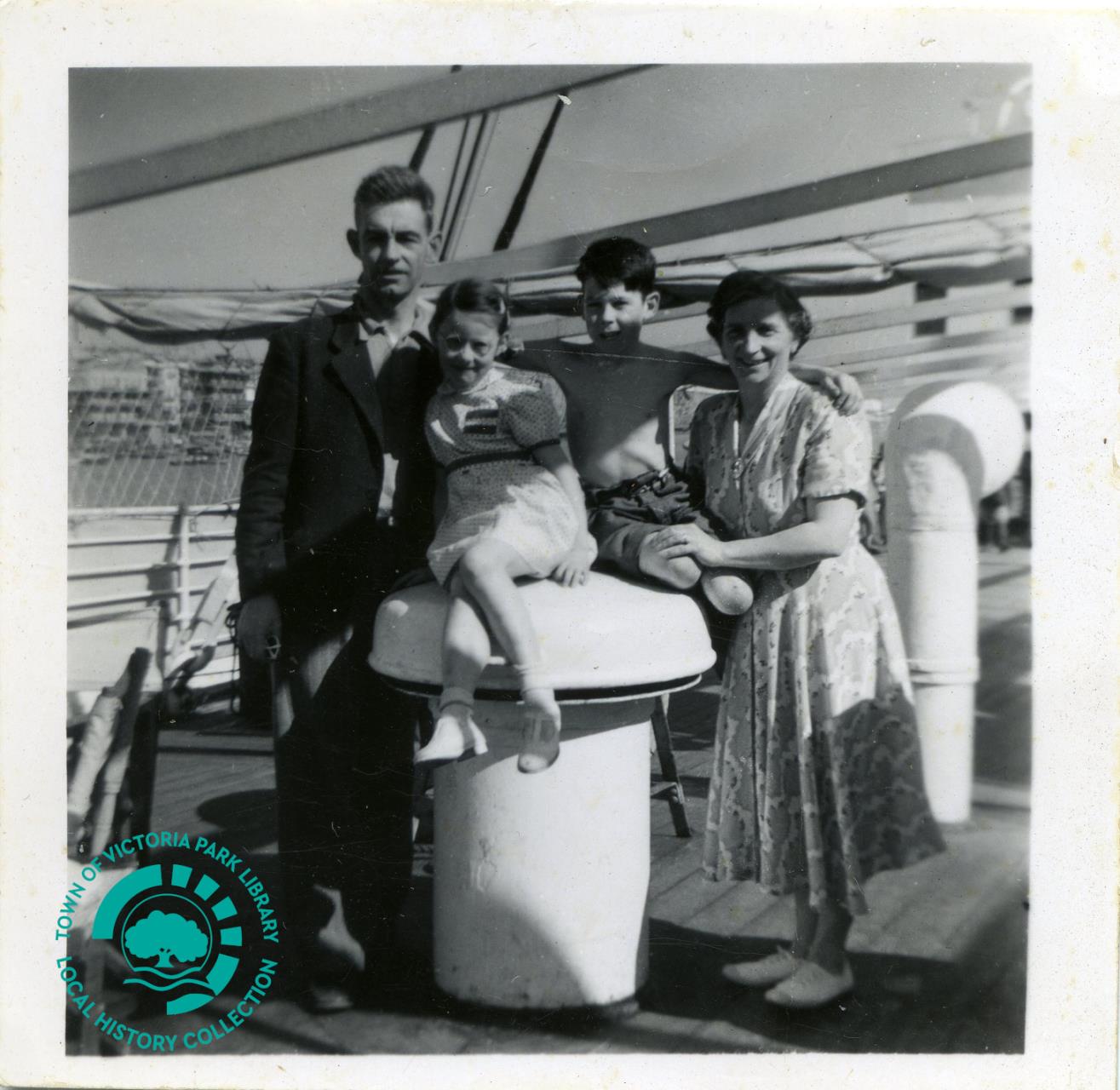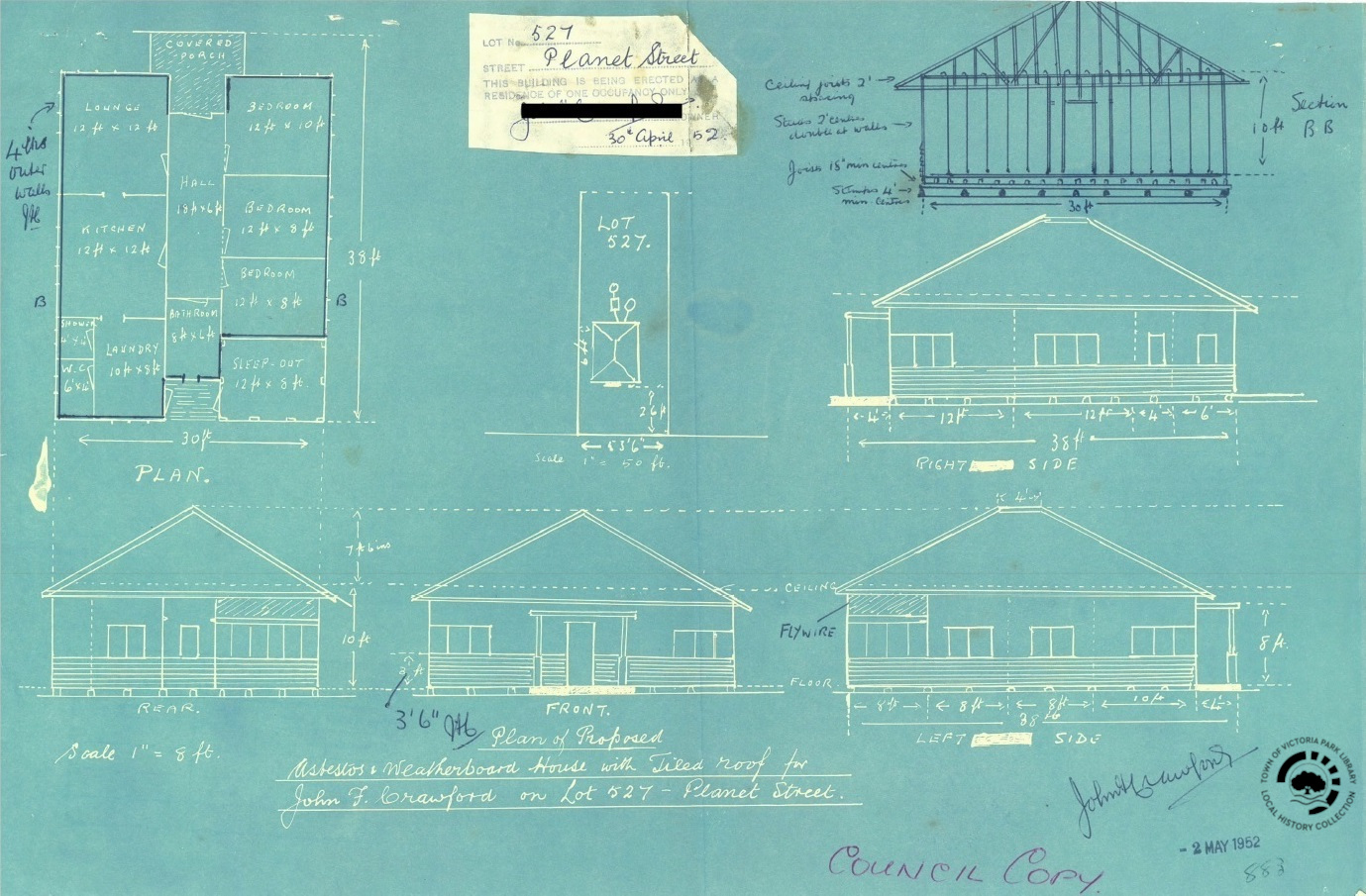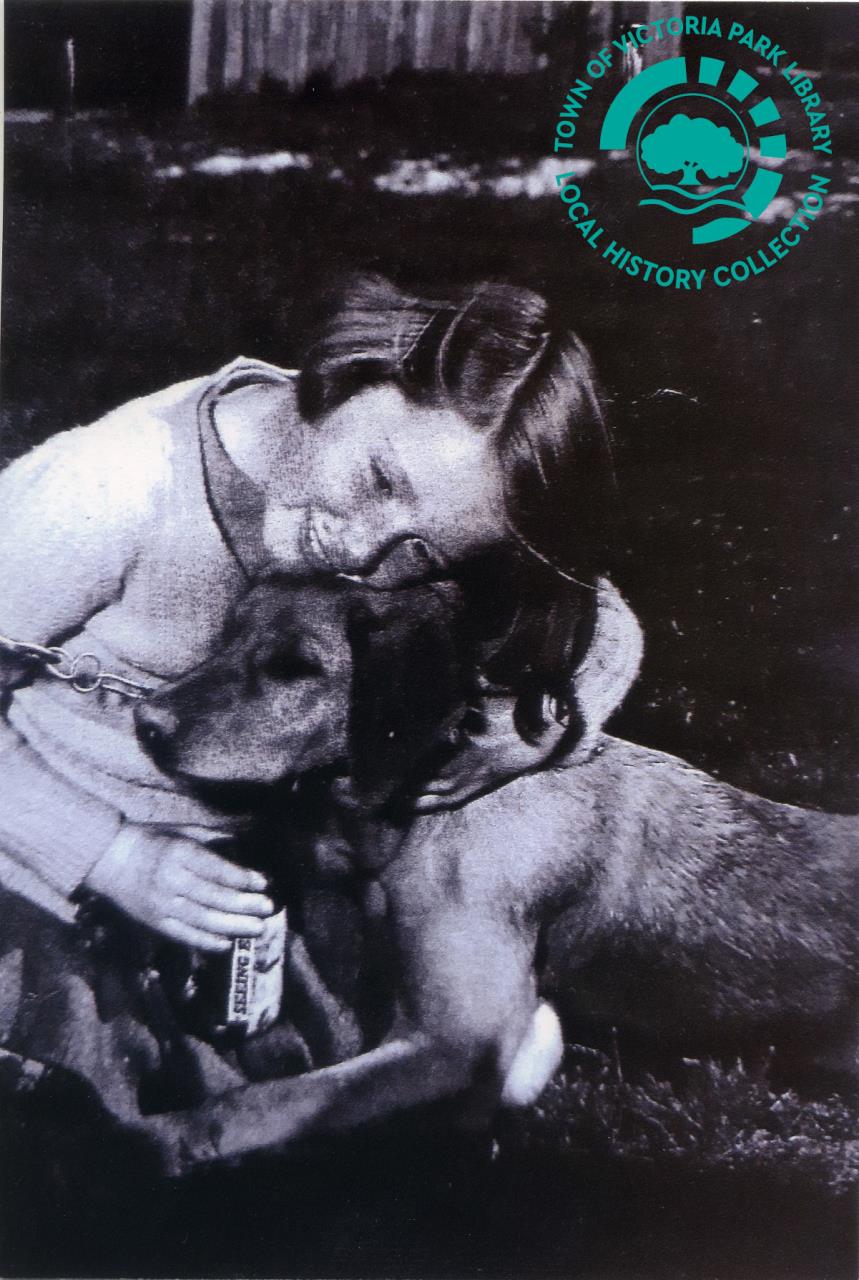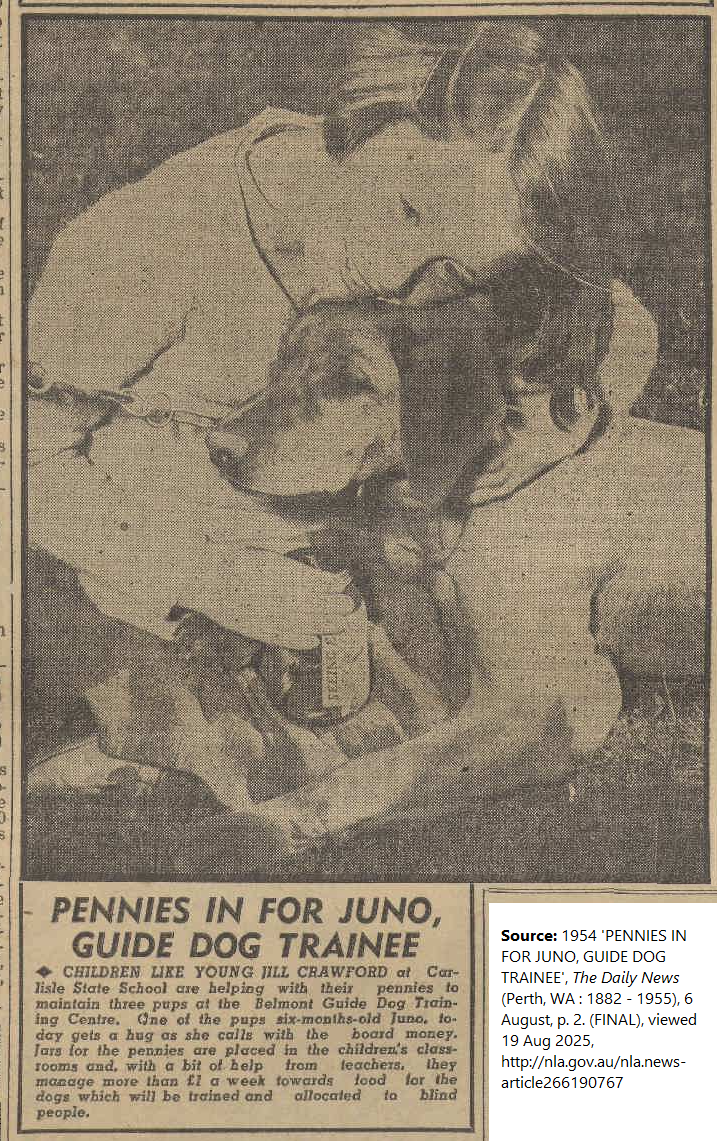Published on Tuesday, 19 August 2025 at 4:28:50 PM
This week we continue our celebration of the recent 2025 Local History Awards. Last week we began our look at entries made into the Personal Memoirs category and this week we feature Part One of Hilary Williams recollections of being a ten-pound Pom and childhood days and fun growing up in Carlisle.
Personal Memoirs
“The Way We Were” – by Hilary Williams
-Part One-
This is a Vic Park area memoir according to my life experience and will be as accurate as my aging mind can produce. I hope the format is interesting and readable enough, and deep research is not a high priority to consolidate accuracy, if it IS a memoir. My age precludes much personal affirmation from acquaintances but at this stage my long term memory has much credibility, certainly more than short. Perhaps a little poetic licence here and there may be needed.

PH00461-02 The Crawford Family aboard 'SS Cheshire', on the way to their new home in Australia, 1952. Standing left and right are John and Mary Crawford, and sitting are their children Hilary (also known as Jill) and Andy.
Courtesy of Hilary Williams. Local History Collection, Town of Victoria Park Library Service
In The Beginning
1952 saw my family arrive post war, as ten-pound Poms. My father had worked in the Philippines till the Great Depression, then returned by necessity to Glasgow, Scotland. He worked in the police force pre-war, as jobs were very scarce, then during and Post war, as so called ‘essential services’. He then hankered for a return to a warmer climate, thus destination Australia.
We initially took residence in Rutland Avenue near Brigg Street at the back of the normal home of long term Scots friends, who were also earlier migrants, post war. This took the form of two modified car boxes tacked together and covered with tar paper on the walls and rickety roof, with big curtains for nominal privacy inside and a very rough plank floor. Bathroom facilities were used in the adjacent house, though most hygiene was by boiling and using the kettle for everything in some manner. The toilet was an outside dunny, still very common at that time and had the inevitable yellow flowering toilet vine on a trellis outside for added privacy and decoration.
Next door was a fabulous playground unsurpassed, excellent for playing hidey and chasey. There were abandoned saw pits and tunnels about a metre deep, quite safe, with sawdust floors where I believe cut wood had been stored and dried carefully in order to have straight hardwood for the building of the burgeoning post war Perth. These were eventually removed and evidently the sawmills were expanded or shifted to the vast area across the railway line where the State Sawmills extended for a long way along the railway line on the Vic Park side. At seven years of age it was not a great point of interest, simply miles of stacked wood and logs across Rutland Ave and stacked along the railway line.
Indeed I do remember steam trains chuffing along on the Armadale line, train whistle blowing periodically, and the odd soot in the eye if you opened the sash windows for air when you travelled by train. Oats St station did not yet exist, it was Welshpool to Carlisle. Look at it all now! Mmmmmmmm.
Bicycles took us everywhere, my father returning to his previous profession as accountant at Jasons Industries with their aluminium kitchen ware, and later, outdoor furniture and my mother to Johnsons Laundry, slogging in the heat. Both were in the Welshpool industrial complex and my elder sister rode to work at a local grocer shop, till old enough to enrol in nursing. This shop was located next to where Milnes grain storage towers still stand with Chamberlains, Plaster ceil and many others also located there.
My older brother and I pedalled to and from Carlisle Primary each day where I also remember picking kangaroo and pussy paws, spider and donkey orchids and also glorious purple hovea. It was all largely bush, dotted with old established homes in between and State Housing development on that route was just starting. We also used to eat ‘puddings’, the seeds of Guildford grass on the ovals, prevalent in October at sports carnivals at Peet Park.
Kindly neighbours were hosed in grand really old pre-1920s well-kept brick houses. These were built many years before in Rutland Ave, along the railway line. They allowed us to climb the enormous mulberry trees, to pick and eat to our hearts content. In season, we often came home a reddish purple. Green mulberries were considered the only cleaning solution. Also offered in February, were copious grapes from the vines which inevitably lined the access lane down to the thunderbox, outhouse or dunny, whichever term was preferred. The collector always was termed the ‘dunny man’ and his vehicle the dunny cart. Rarely the night cart, unless you were really posh.
One day when offered grapes to take home, for the family, my mother found a single pie sized, paper bag for me, having experienced the constraints of post war rationing in Scotland. My grape lady laughed uproariously and sent me home with a full tray that my 7 year old self could hardly carry. I do not remember dates, but the steam and whistle of the Armadale to Perth trains gradually gave way to diesel and klaxon and we no longer made daisy chains from dandelions from the rail verge.
Our Wee House... The Build and Moving In
My Father and mother lost no time in acquiring Lot 527, becoming 145 Planet St. of one quarter acre and proceeded to build our own weatherboard, asbestos and tile house in the common inexpensive style of the day. I am proud to say it is still there, and the current owner, kindly gave me a copy of the house plan my father drew up in April 1952. He obviously lost no time in getting started as I remember the SS Cheshire, an ex-troop-carrier in which we sailed, held a funeral service on deck, for the newly dead King in February, as we steamed out of England… destination Perth… Western Australia.
Those were not the days of big equipment. Manual labour prevailed and one of my jobs, as we cleared the block, was to keep the fire going under some enormous stumps, in order to ‘burn them out’, not an easy task with undried redgum hardwood. Please note that at that time, Mercury St was made of heavy super large sleepers, as was Oats St, beyond Orrong Rd, on the way to Tomato Lake. We made tin can stilts with jam tins and string, clomping along happily for hours. Building cubby houses out of woolly bush was a fun thing to do and there was no shortage of bush. Digging the rubbish hole was also assigned to me, as was scrambling under the house, amongst the stumps and redbacks, in due course when building was under way. This was to retrieve ‘stuff’ needing to be kept covered from the weather and thus kept under the house where the stumps were highest on the sloping hill block.

House plan by John Crawford, drawn by his own hand for the house he and his family would built in Planet Street, Carlisle. This house plan was displayed in the Exhibition that accompanied the 2025 Local History Awards.
Local History Collection, Town of Victoria Park Library Service
In the process of the build, the timber frame, was mostly done by Welsh carpenter friend Taffy Davies with the assistance of our family, mainly Dad and brother. No power drills, all hand saws etc. I actually remember Dad saying ‘wandoo won’t do’ when bending nails into the flooring. Expletives I believe were kept from little ears.
Now to start name dropping… the plumbing, including the septic tank sinking was overseen by one Mick Lee who worked from a plumbing business at the corner of Mars and Oats St. My job was to dig sand out at the bottom of the hole, into the bucket, as the tank slid slowly down into the wet sand. Each bucket was hauled up by Mick and other stronger bodies, till the job was deemed completed. Not bad, playing with the future Lord Mayor in the sand at aged about eight. I can hear Welsh Taffy looking down, laughing and asking, ‘How high are you down now?’ Tiling was done by neighbour’s grandson, again with our family and friends’ help.
We also assisted South African friends, build their house in Tuckett St made of cement bricks, moulded in wooden batas. Many of these folk had migrated at that time to escape the Mau Mau terrorists. I became quite useful, in my opinion, in helping to make these, a method also used commonly to build at that time. Yes, renovated and much fixed up, it is still there.
In due course, when our house was just liveable, I remember Dad in the mornings putting on cycle clips, taking his bike from the four we had, lined up on the side of the house and pedalling up the hill of Planet St toward Welshpool and on to Jason Industries. By the way, we all maintained our own bikes, including me. We oiled chains, tightened as necessary, tyre pumped with hand pumps and puncture fixed. We occasionally repainted, hard work for the youngest… My Mother now headed off in the other direction to her new job at the house and office of one Councillor Harold Hawthorne. I suspect you have heard of him and also perhaps his trusty foreman, Tom Wright. His business was Cotton Traders, throwing out empty hessian bags to household lawns, to be picked up, hopefully full, at the letter box the following week. Mum worked at the Office/house/Clothes shed up the road.
The actual factory where the rags were sorted into different useful industrial categories, was diagonally adjacent to our house at the Oats St corner and the building is also still there. Another smaller shed, became almost a predecessor of Salvos or Good Sammy’s and was located at the back of the Hawthorne home, number 97 from memory, near the corner of Lion. A part of Mum’s job was to be a second mother in the home, and answer the phone for orders, sort the good wearable clothes sent up from the big factory into categories and take money from the mostly migrant customers, Slav, Italian, Poms, Greek and sundry other post war Europeans and also some Aboriginals all looking for cheap work clothes. They all regularly frequented Cotton Traders esteemed shed. My brother and I were also dressed well, as Mum had first choice of supply!
At that time I do not remember a great number of Asians of any description. How things have changed! This is reflected in the length and breadth of Albany Hwy in particular.
Unfortunately Dad died of a heart attack just before my 10th birthday, but our house was near finished by then. Money was tight so, shortly after, I took over my brother’s gardening job at the Hawthorne residence and he went on to more lucrative things. With Mum there to supervise, I received the magnificent sum of 10 bob a week!

PH00461-01 Hilary Crawford (also known as Jill and later her married name of Williams) with a Guide Dog, 1954.
This photographed was taken by a photographer from The Daily Mail and appeared in an article about a fundraising initiative run by local schools at the time. This photograph was not in Hilary’s entry but donated to us later to include on display along with her written entry for the purposes of the accompanying Exhibition.
Local History Collection, Town of Victoria Park Library Service.
Other Transport
At that time, there was the Carlisle Bus Service with the main sheds and depot at the corner of Lion and Mars and later taken over by the MTT. Not top of the range service or busses, but most convenient to us with a stop, going to the City, 50 metres from home. Ther terminus was at Oats and Tuckett St, and the route carried on to Star St and meandered through Lathlain via Streatley St to Gt Eastern Hwy. This is now Burswood Pade and the new Great Eastern was established in due course. We all know the phenomenal Burswood development of recent times. Then on to the city with the conclusion on Georges Tce along with many other feeder destinations south and east of Perth. There was also a timetable option of the Min Street route. The newish Oats St railway station was built and resembled a big bus stop but provided another easy option of train travel to the city. Look at it now. How times changed and are changing even more currently.
While we are thinking of the Oats St station, in that neck of the woods, near Carlisle Tafe, at that time, we kids often caught tadpoles for many hours on end, and also at the bottom of Bishopsgate St. in the reedy winter swamps. I have resumed that water connection currently by swimming at Aqualife, virtually next door, regularly and enjoy some interaction with one and all of the myriad Asians, oldies, South Americans, Africans, therapy needers and Fifo bods.
This new diversity is also reflected at The Leisure Centre where I now play Pickleball… Kiwi, Nepalese, mothers, Afghan, old, young, Aussie, Chinese, grandchildren, Filipino are all part of the changing face of Vic Park.”
-End Of Part One-
Next week’s #TimeWarpTuesday will feature Part Two of Hilary’s entry into the Personal Memoirs category as we continue our journey back through time in the lives lived in Victoria Park and Suburbs.
We hope you are enjoying this celebration of Local History, and the work of those who have taken the time, talent and energy to submit entries into the 2025 Local History Awards and thus helped us record our stories for the benefit of all those to come. We can tell the stories, because you care and have shared with us in the first place.
#LoveVicPark

Newspaper article ‘Pennies In For Juno, Guide Dog Trainee’, The Daily News, 6 August 1954, p . 2. Courtesy of Trove and the National Library of Australia
Back to All News